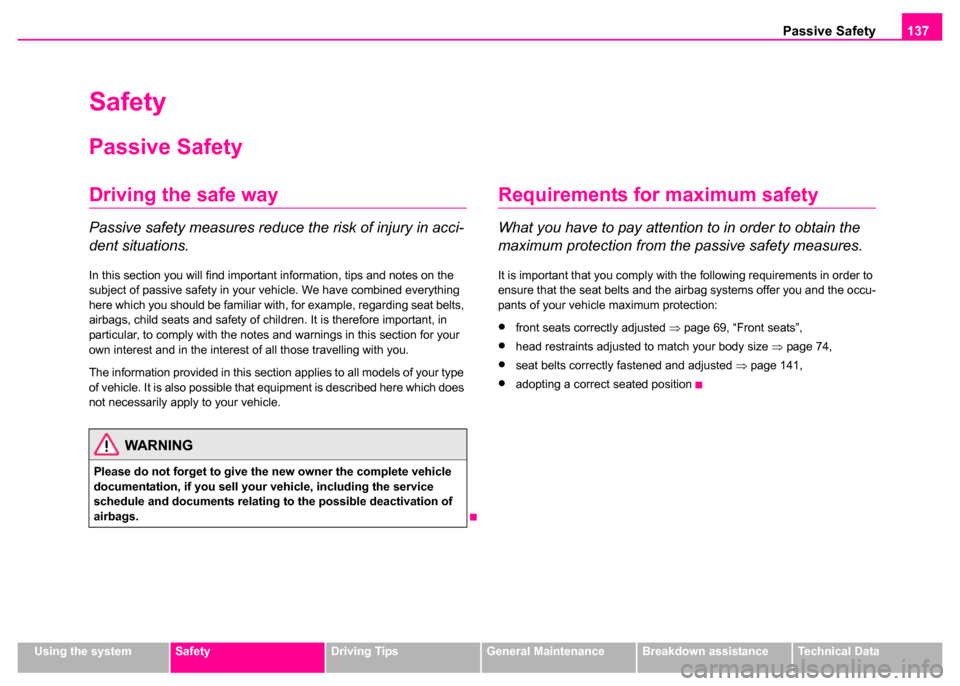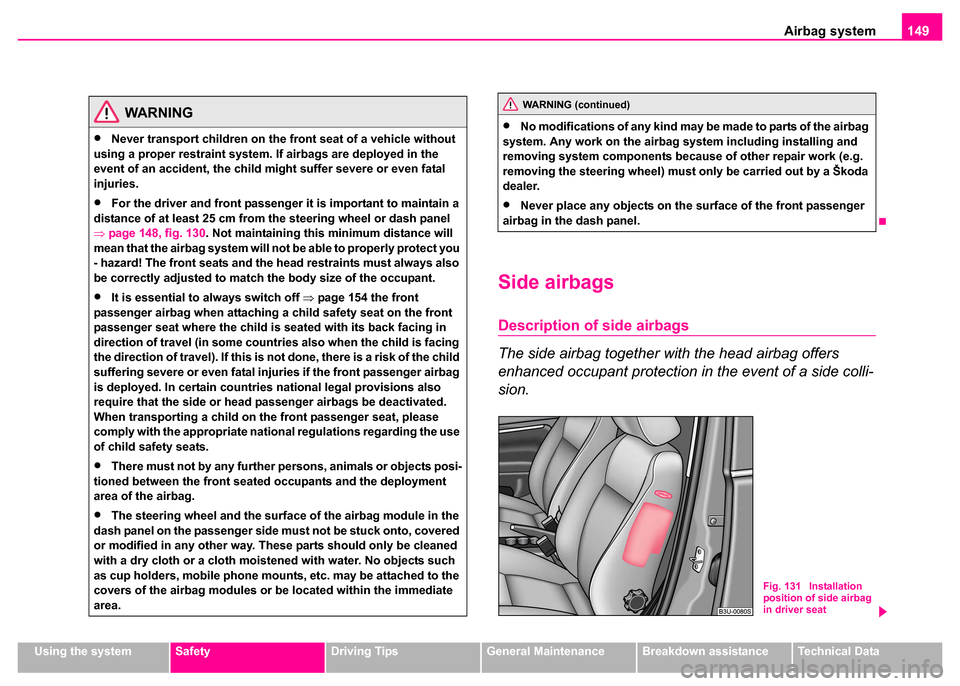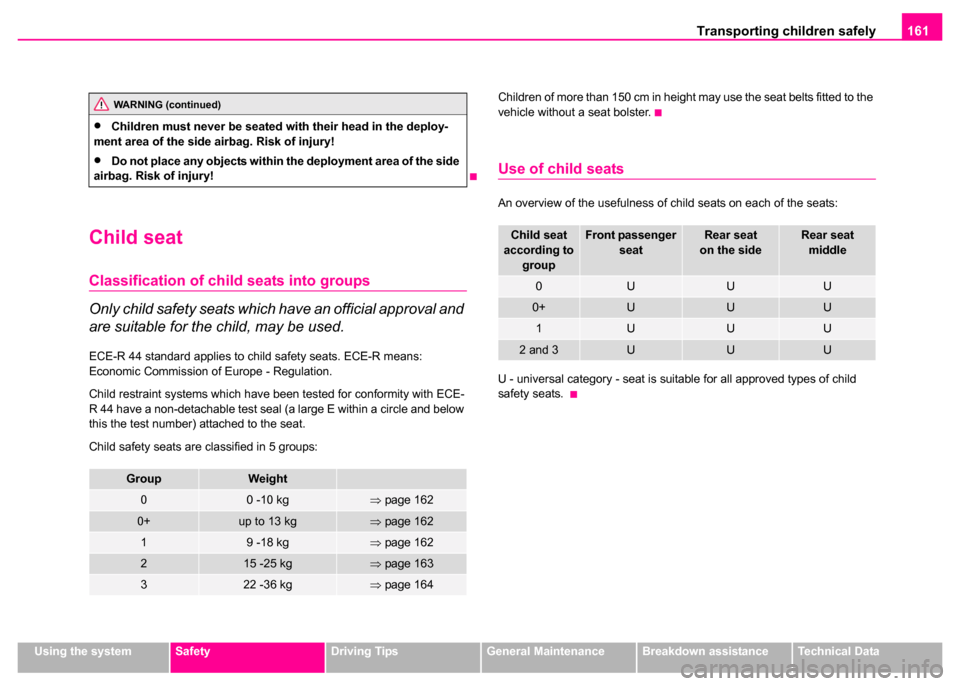child restraint SKODA SUPERB 2003 1.G / (B5/3U) Owner's Manual
[x] Cancel search | Manufacturer: SKODA, Model Year: 2003, Model line: SUPERB, Model: SKODA SUPERB 2003 1.G / (B5/3U)Pages: 259
Page 138 of 259

Passive Safety137
Using the systemSafetyDriving TipsGeneral MaintenanceBreakdown assistanceTechnical Data
Safety
Passive Safety
Driving the safe way
Passive safety measures reduce the risk of injury in acci-
dent situations.
In this section you will find important information, tips and notes on the
subject of passive safety in your vehicle. We have combined everything
here which you should be familiar with, for example, regarding seat belts,
airbags, child seats and safety of children. It is therefore important, in
particular, to comply with the notes and warnings in this section for your
own interest and in the interest of all those travelling with you.
The information provided in this section applies to all models of your type
of vehicle. It is also possible that equipment is described here which does
not necessarily apply to your vehicle.
Requirements for maximum safety
What you have to pay attention to in order to obtain the
maximum protection from the passive safety measures.
It is important that you comply with the following requirements in order to
ensure that the seat belts and the airbag systems offer you and the occu-
pants of your vehicle maximum protection:
•front seats correctly adjusted ⇒page 69, “Front seats”,
•head restraints adjusted to match your body size ⇒page 74,
•seat belts correctly fastened and adjusted ⇒page 141,
•adopting a correct seated position
WARNING
Please do not forget to give the new owner the complete vehicle
documentation, if you sell your vehicle, including the service
schedule and documents relating to the possible deactivation of
airbags.
Page 150 of 259

Airbag system149
Using the systemSafetyDriving TipsGeneral MaintenanceBreakdown assistanceTechnical Data
Side airbags
Description of side airbags
The side airbag together with the head airbag offers
enhanced occupant protection in the event of a side colli-
sion.
WARNING
•Never transport children on the front seat of a vehicle without
using a proper restraint system. If airbags are deployed in the
event of an accident, the child might suffer severe or even fatal
injuries.
•For the driver and front passenger it is important to maintain a
distance of at least 25 cm from the steering wheel or dash panel
⇒ page 148, fig. 130 . Not maintaining this minimum distance will
mean that the airbag system will not be able to properly protect you
- hazard! The front seats and the head restraints must always also
be correctly adjusted to match the body size of the occupant.
•It is essential to always switch off ⇒page 154 the front
passenger airbag when attaching a child safety seat on the front
passenger seat where the child is seated with its back facing in
direction of travel (in some countri es also when the child is facing
the direction of travel). If this is not done, there is a risk of the child
suffering severe or even fatal injuries if the front passenger airbag
is deployed. In certain countries national legal provisions also
require that the side or head passenger airbags be deactivated.
When transporting a child on the front passenger seat, please
comply with the appropriate nation al regulations regarding the use
of child safety seats.
•There must not by any further persons, animals or objects posi-
tioned between the front seated occupants and the deployment
area of the airbag.
•The steering wheel and the surface of the airbag module in the
dash panel on the passenger side must not be stuck onto, covered
or modified in any other way. These parts should only be cleaned
with a dry cloth or a cloth moistened with water. No objects such
as cup holders, mobile phone mounts, etc. may be attached to the
covers of the airbag modules or be located within the immediate
area.
WARNING (continued)
•No modifications of any kind may be made to parts of the airbag
system. Any work on the airbag system including installing and
removing system components because of other repair work (e.g.
removing the steering wheel) must only be carried out by a Škoda
dealer.
•Never place any objects on the surface of the front passenger
airbag in the dash panel.
Fig. 131 Installation
position of side airbag
in driver seat
Page 158 of 259

Transporting children safely 157
Using the systemSafetyDriving TipsGeneral MaintenanceBreakdown assistanceTechnical Data
Transporting children safely
What you should know about
transporting children!
An introduction to the subject
Accident statistics have revealed that children are gener-
ally more safely transported on the rear seats than on the
front passenger seat.
Children younger than 12 years of age should normally travel on the rear
seat of the vehicle (take note of any national legal provisions which differ
from this). They should be secured there by means of a child restraint
system or by using the existing seat belts depending on their age, body
size and weight. The child seat should be mounted behind the front
passenger seat for safety reasons.
The physical principle of an accident does, of course, also apply to chil-
dren ⇒page 139. They differ from adults in that their muscles and bone
structure of children are not yet fully developed. Thus children are
exposed to increased risk of injury.
Children should be transported by using special child safety seats in order
to reduce this risk of injury.
Use only child safety seats which are officially approved and are suitable
for children and which comply with the ECE-R 44 Standard, which classi-
fies child safety seats into 5 groups ⇒page 161, “Classification of child
seats into groups”. Child restraint systems which have been tested for
conformity with ECE-R 44 have a non-detachable test seal (a large E
within a circle and below this the test number) attached to the seat. We recommend that you use child safety seats from the Škoda range of
genuine accessories. These child seats were developed and also tested
for use in Skoda vehicles. They fulfil the standard ECE-R 44.
Note
Any varying national legal regulations take priority over the information
provided in these instructions for use, or stated in this chapter.
Important safety informat
ion on using child safety
seats
Correct use of child safety seats considerably reduces the
risk of injury!
WARNING
Always comply with legal provis ions and instructions from the
relevant child safety seat manufacturer when installing and using
the child seat ⇒ in “Important safety information on using child
safety seats”.
WARNING
•All the occupants of the car - in particular children - must wear
a seat belt when the car is moving.
Page 159 of 259

Transporting children safely
158
Use of child safety seats on the front passenger seat
Child safety seats should always be attached to the rear
seats.
We recommend, for safety reasons, that you always mount a child
restraint systems on the rear seats whenever possible. If you still decide,
however, to use a child safety seat on the front passenger seat then you
must pay attention to the following warnings in connection with the use of
the airbag system on the front passenger seat:
WARNING (continued)
•Children less than 1.50 m in he ight or younger than 12 years
must not use a normal seat belt without a child restraint system
otherwise this may result in in juries to the stomach and neck
areas. Comply with the national legal requirements.
•One should never carry children, and also not babies! - on one's
lap.
•You can transport a child safely in a suitable child safety seat
⇒ page 161, “Child seat”!
•Only one child may be fastened with a seat belt into a child
safety seat.
•Never leave the child sitting unattended in the seat.
•Never allow your child to be transported in a vehicle without the
use of a suitable restraint system.
•Children should also never stand up in a vehicle or kneel on the
seats when the vehicle is moving. In the event of an accident the
child will be thrown through the vehicle and may as a result suffer
fatal injuries, and also injure other occupants.
•Children are exposed to an increased risk of injury in the event
of an accident if they lean forward or adopt an incorrect seated
position when the vehicle is moving . This particularly applies to
children who are transported on the front passenger seat if the
airbag system deploys in the event of an accident. This can result
in severe or even fatal injuries.
•It is important that the belt webbing is properly routed if the seat
belts are to offer their maximum protection ⇒page 141, “How are
seat belts correctly fastened?”. Pay particular attention to the
information provided by the manufacturer of the child safety seat
regarding correct routing of the belt. Seat belts which are not
correctly adjusted can themselves cause injuries even in minor
accidents.
WARNING (continued)
•Safety belts must be checked to ensure that they are running
properly. One should also ensure that the belt is not damaged by
sharp-edged fittings.
•It is essential to always switch off ⇒page 154 the front
passenger airbag when attaching a child safety seat on the front
passenger seat where the child is seated with its back facing in
direction of travel (in some countries also when the child is facing
the direction of travel). If this is not done, there is a risk of the child
suffering severe or even fatal injuries if the front passenger airbag
is deployed. In certain countries national legal provisions also
require that the side or head passenger airbags be deactivated.
When transporting a child on the front passenger seat, please
comply with the appropriate national regulations regarding the use
of child safety seats.
•Particular care is required if use is made of child restraint
systems which are attached together with the seat belts fitted to
the vehicle. It is important to ensure that the bolts are inserted into
the threaded hole over their entire length and are tightened to a
torque of 35 Nm.
Page 162 of 259

Transporting children safely 161
Using the systemSafetyDriving TipsGeneral MaintenanceBreakdown assistanceTechnical Data
Child seat
Classification of child seats into groups
Only child safety seats which have an official approval and
are suitable for the child, may be used.
ECE-R 44 standard applies to child safety seats. ECE-R means:
Economic Commission of Europe - Regulation.
Child restraint systems which have been tested for conformity with ECE-
R 44 have a non-detachable test seal (a large E within a circle and below
this the test number) attached to the seat.
Child safety seats are classified in 5 groups: Children of more than 150 cm in height may use the seat belts fitted to the
vehicle without a seat bolster.
Use of child seats
An overview of the usefulness of child seats on each of the seats:
U - universal category - seat is suitable for all approved types of child
safety seats.
WARNING (continued)
•Children must never be seated with their head in the deploy-
ment area of the side airbag. Risk of injury!
•Do not place any objects within the deployment area of the side
airbag. Risk of injury!
GroupWeight
00 -10 kg⇒ page 162
0+up to 13 kg⇒page 162
19 -18 kg⇒page 162
215 -25 kg⇒page 163
322 -36 kg⇒page 164
Child seat
according to
groupFront passenger seatRear seat
on the sideRear seat middle
0UUU
0+UUU
1UUU
2 and 3UUU